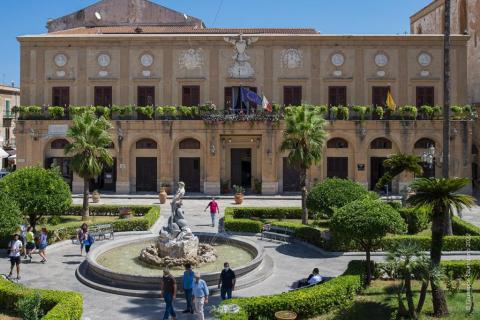An elegant Norman city located 8 km southwest of Palermo, nestled at the foot of Mount Caputo on a spur overlooking the Oreto Valley and the Conca D'Oro, Monreale is the main tourist center of the capital, renowned for the splendor and beauty of its masterpieces, especially the superb and dazzling Cathedral.
The city settlement was born in the 12th century around the Benedictine Abbey, now called the Guglielmo II Monumental Complex, with the establishment of religious orders, followed by the construction, between the 17th and 18th centuries, of various ecclesiastical structures. Since the end of the 12th century, Monreale was surrounded by high walls interspersed with towers, with the aim of defending the abbey complex.
Among other monuments of great artistic value in the historic center of Monreale are: The Benedictine Cloister, which, in size and richness, evokes Islamic courtyards, remaining intact until today, a place of silence and prayer considered one of the most evocative sites in the world. It still maintains its original structure, with a square plan, marked by 26 original arches resting on slender paired columns. The Guglielmo II Monumental Complex, with its imposing facade dominating the homonymous square, is the seat of the Municipal Civic Gallery "Giuseppe Sciortino," which houses works of painting by modern and contemporary artists. From this building, crossing an archway, one enters a large rectangular courtyard, beyond which there is access to the Belvedere, a public garden from which you can admire the splendid panorama of the Conca D'Oro and the city of Palermo. The prestigious Santa Maria la Nuova Municipal Library. Still, in the central Piazza Vittorio Emanuele, you can admire the former Royal Palace, now the seat of the Municipality of Monreale, with its eighteenth-century facade, which incorporates the structures of the ancient Norman palace of Guglielmo II originally connected to the Cathedral. In the same square, there is the Triton Fountain, the work of the Palermo sculptor Mario Rutelli, which symbolizes the victory of man over brute forces.
Among other historical buildings, we find the former Hospital "Santa Caterina," now the seat of Casa Cultura, located along Corso Pietro Novelli, where the Library with its modern collection and the municipal historical archive are housed. Along the panoramic Rocca-Monreale road, you will find fountains including the Fisherman's Fountain, the Dragon Fountain, the Semicircular Fountain, and the Fountain of the Poorhouse.
